|
CD/DVD |
|||||||||
| You can buy all
CDs/DVDs listed at this website. Please pay 18.- Euro for one CD (23.- for the DVD) (+ shipping 2.- Euro inside Europe, 6.- Euro outside Europe) |
|||||||||
| Seraphim
Ensemble Cosmedin |
 |
||||||||
| Stephanie und Christoph Haas carry out a dialogue across the boundaries of time - between the melodies of a liturgical composer of the 12th century and the instrumental compositions of a 21st century percussionist. Magnificent, fresh and dynamic interpretations of some of the most challenging chants of Hildegard von Bingen, confronted and merged with the compositions of Christoph Haas: "islands of sound" whose burning intensity challenges the whole spectrum of our sense of hearing, leading us into the heart of reality. | |||||||||
| "This is perhaps the deepest bond between the music of Christoph Haas and Hildegard of Bingen: that they both open up the way for what can not be spoken of. The Ensemble Cosmedin has achieved the musical transformation of a supracultural vision: that of man rooted in the earth, but reaching up to heaven. Christoph Haas creates "islands of sound" whose burning intensity challenges the whole spectrum of our sense of hearing, leading us into the heart of reality. This is perhaps the deepest bond between the music of Christoph Haas and Hildegard of Bingen: they both open up the way for transcendence." (Dr. Barbara Stühlmeyer) | |||||||||
| "Almost imperceptibly, the tambura pares a sound out of the silence. The voice spirals gradually upward, growing in luminosity as it rises, until at last it reaches its zenith like a radiant star. This music exhales a wonderful inner peace and an almost supernatural joy. The songs of Hildegard of Bingen and the instrumental compositions of Christoph Haas both communicate resonant stillness. Our hearts are won by the performers' unpretentious commitment, which lends their music a high degree of authenticity." (Gabriele Karen Metsker) | |||||||||
| Music-samples (mp3) | |||||||||
| O Jerusalem | O vos Angeli | O clarissima mater | O quam pretiosa | ||||||
| Canticum |
O choruscans lux stellarum |
Saltatio | |||||||
|
|
|||||||||
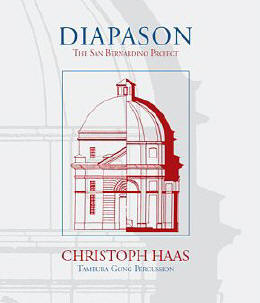 DIAPASON - The San Bernardino Project
Christoph Haas: framedrums,
tubular bells, tambura, berimbao, gong, percussion German multiinstrumentalist Christoph Haas converted harmonical spatial dimensions into sounds and rhythms.
Video-sample (real-player, 18 MB) |
|||||||||
|
"Christoph Haas creates, within an ideal setting, a world of sound that possesses innovative force. This visionary percussionist blends ancient music theory with structural elements of the mediaeval chorale to create an irresistible sound experience that incorporates the listener." (Dr. Barbara Stühlmeyer) "It is Christoph Haas's virtuosity and incredible density of sound that make this recording so impressive. I have rarely heard instruments captured so vividly and with such a wealth of nuance." (Klassik.com) For Pythagoras the philosopher, born around 580 B.C., numbers opened up access to the world. Following on from his studies in Egypt, which provided him with access to ancient oriental knowledge, he began to investigate the fundamental relationships between algebra, geometry and music, using for this purpose a single-stringed instrument, the monochord (monos-chordos). Music was for him the ultimate expression of harmonic proportions. Pythagorean thinking continued to exert a decisive influence for centuries. Music is to
time as architecture is to space: Vitruvius (1st century B.C.) passed on
the ancient theory of proportion to us in his writings on architecture.
The architectural aesthetics of the Renaissance relate explicitly to the
ancient theory of proportion. Alberti observes, “the same numbers by means
of which the agreement of sounds affect our ears with delight are the
very same which fill our eyes and minds with wondrous joy." The present recording has as its theme the relationships between number and form, space and music, architectural and musical proportions. Space itself is the underlying musical performer, determining tempo and musical texture. It is sound that first endows this space with time. In the Chiesa Rotonda di San Bernardino (Graubünden) we found the ideal setting for our recording: a church built in the tradition of the Greco-Roman round temple and clearly inspired by Palladio’s round buildings. The ground plan is in the form of a circle encompassing a cross, a symbolic meeting of cycle and number, of infinity and a world transcending into spirituality. Flagstones of local granite form a path around the inner walls and lead in towards the centre. The central stone corresponds to the illuminated lantern window, creating a vertical axis between floor and cupola. In this role of “axis mundi”, the sacred space joins heaven and earth in symbolic union. The abundance of integer (and thus musical) proportions in this building is remarkable. The total height is twice the diameter, and the height of the rotunda is twice that of the cupola. For the Pythagoreans, the ratio of 1 : 2 constituted the harmonic relationship par excellence. It corresponds musically to the octave interval and rhythmically to double tempo. The acoustic qualities are quite extraordinary: the interior space acts as a large resonating-chamber, multiplying the volume and duration of each sound. This acoustic space extends almost infinitely, transcending its architectural confines. It calls for ascetic music, music that allows enough time for sounds to unfold fully and die away. „Diapason“ is music for this space - harmonic proportions converted into sounds and rhythms, woven into the acoustics of the rounded cupola. |
|||||||||
|
|
|||||||||
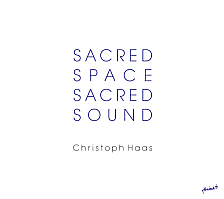
Sacred Space - Sacred Sound Christoph Haas: framedrums, tubular bells, tambura,
berimbao, gong, percussion Audio-CD, total time 54:55 |
|||||||||

The present recording has as its theme the relationships between number and form, space and music, architectural and musical proportions. Music is to time as architecture is to space: Vitruvius (1st century B.C.) passed on the ancient theory of proportion to us in his writings on architecture. St. Augustine (354 - 430) sees in number "the shaping force of measure and order, the source of aesthetic perfection and beauty". The architectural aesthetics of the Renaissance relate explicitly to the ancient theory of proportion. Alberti observes, "the same numbers by means of which the agreement of sounds affect our ears with delight are the very same which fill our eyes and minds with wondrous joy." Goethe later describes sacred architecture as "silent music" and Schelling likens cathedrals to "frozen music". Space itself is the underlying musical performer,
determining tempo and musical texture. It is sound that first endows this
space with time. I The actual CD of german composer and multi-instrumentalist Christoph Haas is music for this space - harmonic proportions converted into sounds and rhythms, woven into the acoustics of the rounded cupola.
|
|||||||||
| Music-samples (mp3) | |||||||||
| Ala | Pian San Giacomo | Oktos | |||||||
| Dodici | Diapason | Lux Stellarum | |||||||
|
|
|||||||||
|
|
|||||||||
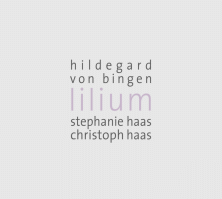
"Lilium" Stephanie Haas, voice Compositions by Hildegard von Bingen and Christoph Haas Recorded in St. Antonius, Stuttgart, August 2001
|
|||||||||
| Music-samples (mp3) | |||||||||
| Alleluia | O virga ac diadema | Perdito | Ave, generosa | ||||||
| O gloriosissimi | O viridissimi virga | ||||||||
| The concept: "As a letter by Hildegard's last secretary, Guibert de Gembloux, testifies, her songs were performed in her convent with instrumental accompaniment. Stephanie und Christoph Haas chose a concept which places the songs into a context of interpreting instrumention. In this concept (which exceeds the usual custom), the instruments are neither framework nor decorative adition - they are a substantial part of the performance. By starting from a deep understanding of Hildegard's words, Stephanie Haas is able to interpret these songs in an ideal way. In her interpretation the musical accents naturally coincidate with the accentuation of the written text, making it evident where Hildegard wanted to emphasize crucial thematic points in her texts by the melodic line, and where she musically links single text statements in a way that generates a new meaning which contrasts and vivifies traditional theological models, lets them to be seen in a new light. Benedict's rule that Hildegard lived by says, that in sung prayer our spirit and our voice should be in harmony - a unison Benedict wishes to be accomplished in our hearts. On this recording Stephanie Haas makes audible the acoustical realization of this approach. Christoph Haas creates his instrumental part analogous to Hildegard von Bingen's composing style. By the choice of instruments and rhythms he gives sound to the medieval understanding of world. The result is a kind of "Moyen Age imaginaire", giving us access to a strange yet wellknown world." Dr. Barbara Stuehlmeyer |
|||||||||
|
|
|||||||||
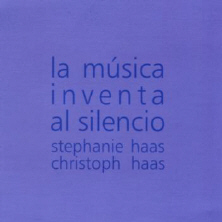 "la musica inventa al silencio"Stephanie Haas, voice Christoph Haas, percussion (gong, musical bow, gong, tar, tambura) Compositions by Hildegard von Bingen, Sofia Gubaidulina, Christoph Haas, Konrad Lechner, Tomas Luzian Recorded in St. Antonius, Stuttgart, August 1999 |
|||||||||
| Music-samples (mp3) | |||||||||
| Enigma II | Enigma III | De Spiritu Sancto - O ignee Spiritus | |||||||
| Elegie | Enigma IV | ||||||||
| "This CD contains a
well-chosen selection of contemporary compositions for percussion and
voice. Christoph Haas' four-part composition "Enigma" (1999) is a red
thread through the recording. Haas, both composer and interpreter, takes
us through an unbelievably broad spectrum of sound with an entire ensemble
of far Eastern percussion instruments. He enables us to hear the richness
of the overtone spectrum of his instruments, and creates a deeply woven
tapestry of melodies and rhythms which evoke both a peacefulness and an
alert attentiveness among the listeners. A second focus of this CD is the
music of Hildegard von Bingen. Our first encounter with her is in
compositions with texts by Sofia Gubaidulina ("The visions of Hildegard
von Bingen"). Gubaidulina succeeds in translating the tension and release
of Hildegard's music into the spread between the highest and lowest tones.
Stephanie Haas interprets Gubaidulina with extreme musical sensitivity and
perfect technique. Her deep understanding of the music makes it
approachable even to those who otherwise have no access to new music. It
is this understanding that originally led Stephanie Haas to the roots of
this music, to the compositions of Hildegard von Bingen."
Dr. Barbara Stuehlmeyer in "Musica Sacra"
"We are witnessing a period of competing views of medieval music, and what makes it particularly exciting is that these views reflect different visions of our own heritage. If you accept the transfor-mation in new music as being of equal validity, then surely "La musica inventa al silencio" is a work of great soundness. The percussion elements function as a bridge to a medieval sound world." Dr. Robert Lug, HR2 - Neue Musik |
|||||||||
|
|
|||||||||
|
|||||||||
| Music-samples | |||||||||
| lolongo Interludes No.4: Sahel Blues | (0:40s, 470 kB, mp3) | ||||||||
| Ex-Trance (La Ira Reprise) | (0:50s, 580 kB, mp3) | ||||||||
| "To give a concert in a
cave has always been a dream of mine. In the summer of 1999 this dream
came true: I was invited to play in the "Hollow Cliff". A veritable
Cathedral in the earth, this cave has a height of 25 meters and
encompasses 6000 cubic meters. To enter the cave is to enter a different
world. Water drips constantly fom the ceiling in the dark and damp
interior, creating a multitude of changing rhythms. Archeological findings
show that humans lived in this cave for thousands of years. People ate
here, sacrificed, made cave paintings, held rituals, sang and drummed. In
preparing this concert, I chose instruments that were probably used by the
early inhabitants of this cave: frame drums, clay pot drums, musical bows
and rattles." C. Haas |
|||||||||
|
|
|||||||||
|
|
|||||||||
| Music-sample | |||||||||
| Konkolo Part 2 | (0:47s, 558 kB, mp3) | ||||||||
|
|
|||||||||
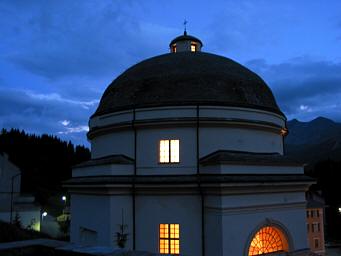
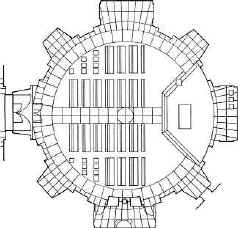 n
the Chiesa Rotonda di San Bernardino (Graubünden) we found the ideal
setting for our recording: a church built in the tradition of the
Greco-Roman round temple and clearly inspired by Palladio's round
buildings.The acoustic qualities are quite extraordinary: the interior
space acts as a large resonating-chamber, multiplying the volume and
duration of each sound. This acoustic space extends almost infinitely,
transcending its architectural confines. It calls for ascetic music, music
that allows enough time for sounds to unfold fully and die away.
n
the Chiesa Rotonda di San Bernardino (Graubünden) we found the ideal
setting for our recording: a church built in the tradition of the
Greco-Roman round temple and clearly inspired by Palladio's round
buildings.The acoustic qualities are quite extraordinary: the interior
space acts as a large resonating-chamber, multiplying the volume and
duration of each sound. This acoustic space extends almost infinitely,
transcending its architectural confines. It calls for ascetic music, music
that allows enough time for sounds to unfold fully and die away. "Musica
Povera - Inside the Hollow Cliff"
"Musica
Povera - Inside the Hollow Cliff"